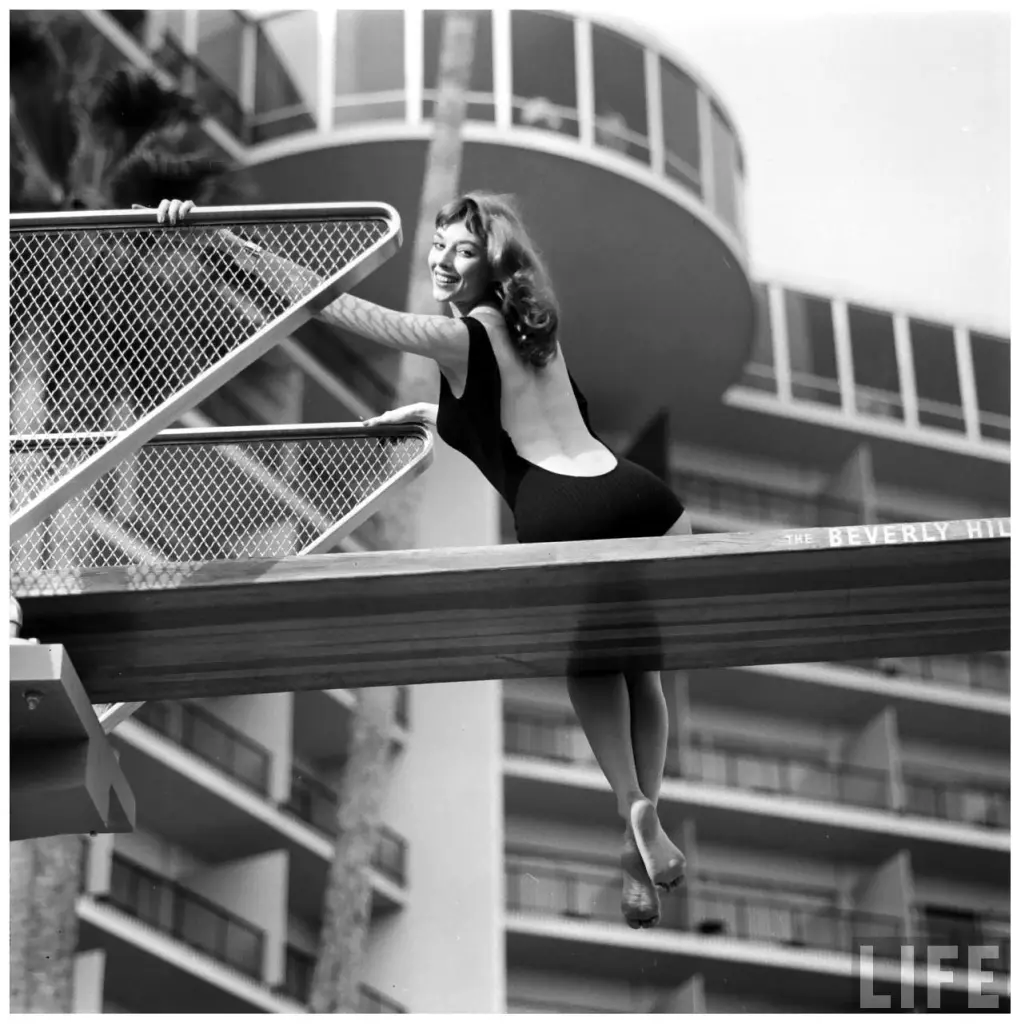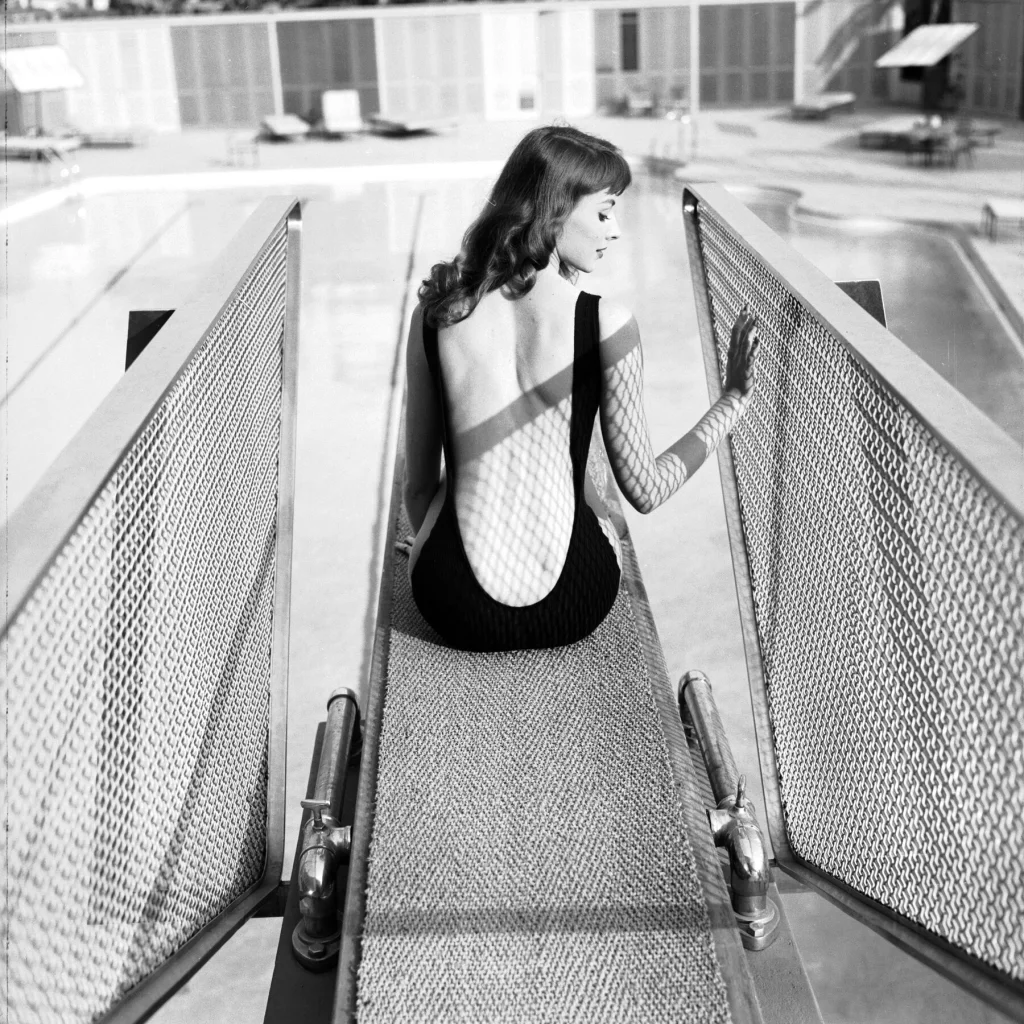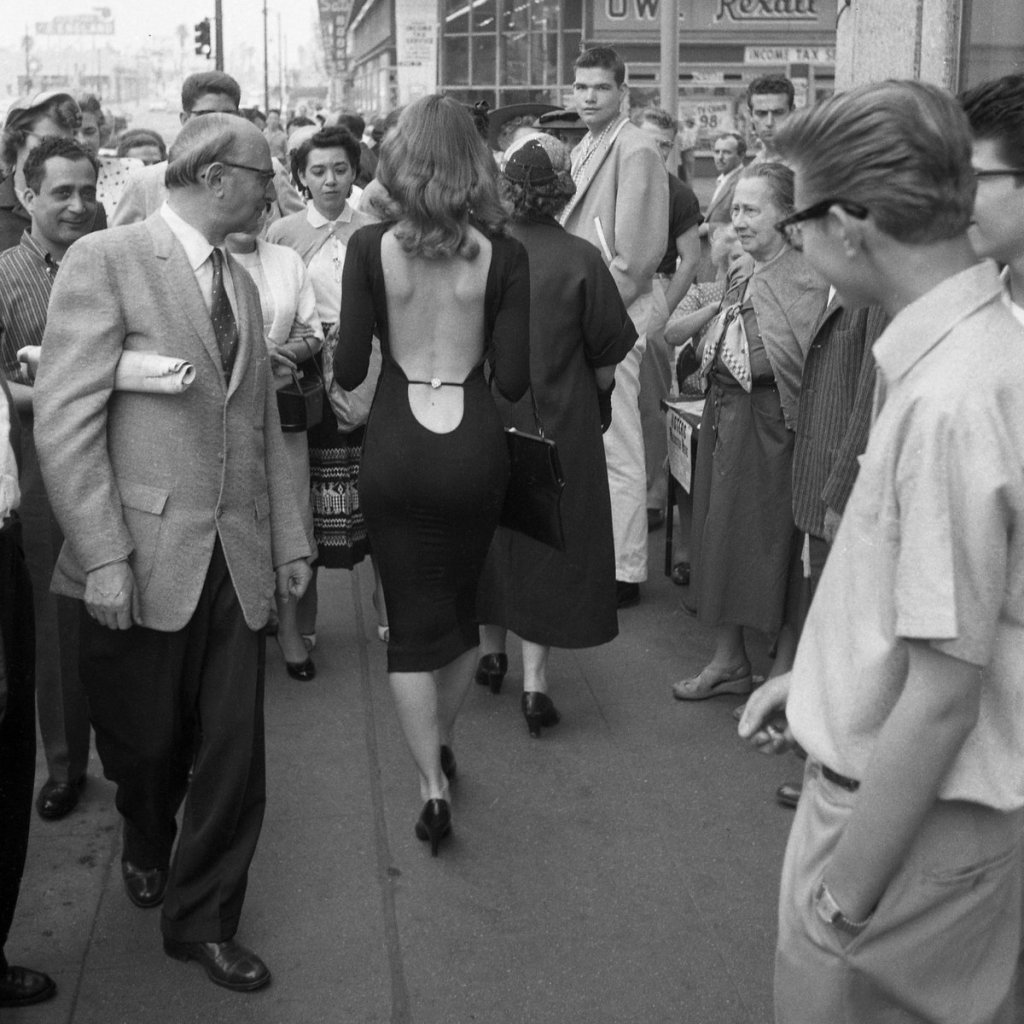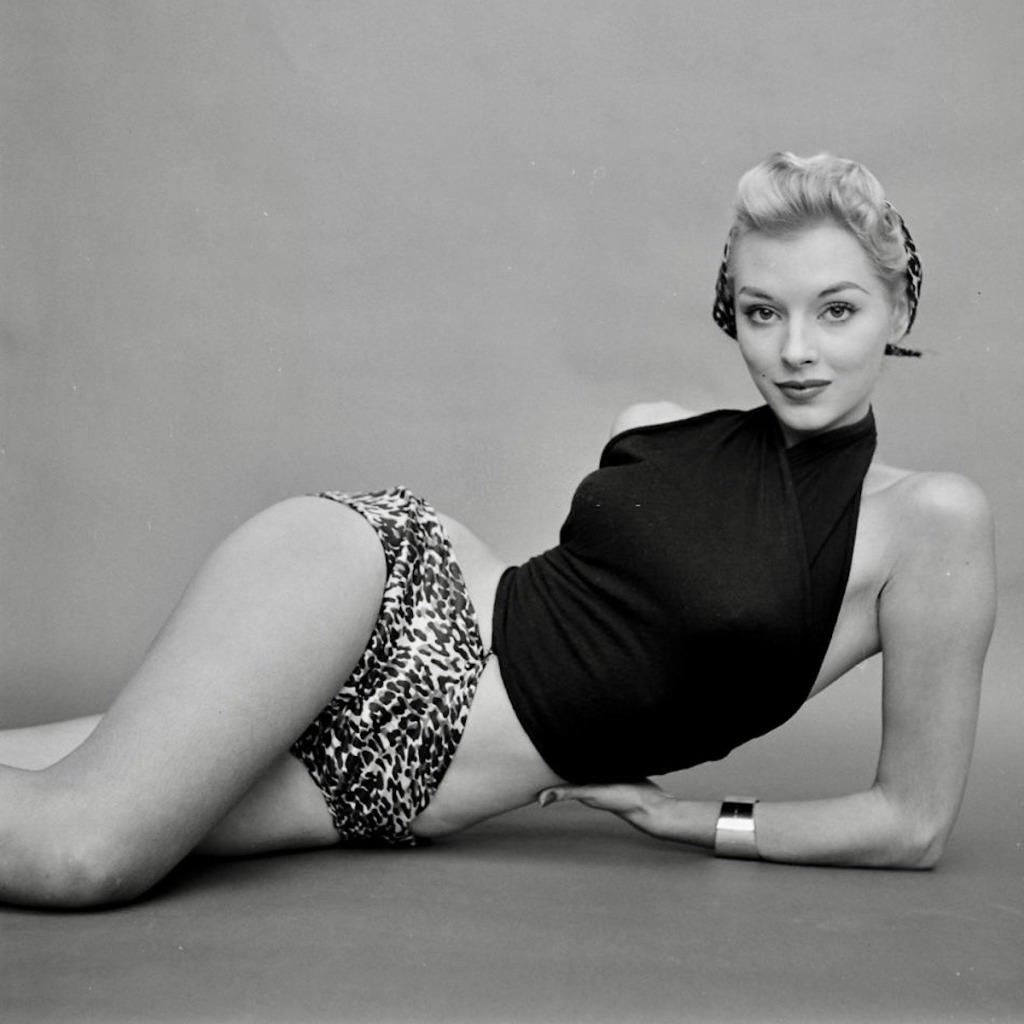


From The New York Times Archives:
The evening of Feb. 28, 1957 in Los Angeles was a balmy one, and the 14th annual Golden Globes awards were in progress at the Ambassador Hotel. Inside, a nervous Hollywood newcomer named Vikki Dougan was about to present the award for Best Supporting Actor to Earl Holliman for his performance in “The Rainmaker.”

Ms. Dougan had slipped on a pink satin backless dress for the special occasion — one of several she’d had custom-made after signing a contract with John Wayne’s production company, Batjac — and covered her shoulders with a mink stole.

Before making her way to the stage to present, she realized she wouldn’t be able to hand off the award, shake Holliman’s hand and hold up her shawl at the same time. She gently let the mantle fall from her shoulders to the ground, revealing her toned, taut and impossibly shapely back as she made her way to the stage.

From that moment onward, Ms. Dougan’s beautiful rear view became tabloid fodder for Hollywood gossip columns — and inspired a profuse number of groan-inducing puns. In a March 29, 1957 Hollywood Today column headlined “Vikki Dougan … Backs Into a Film Career,” Erskine Johnson suggested that Ms. Dougan’s dresses are “lower in the back than a teenager’s hot rod.”

Another Hollywood correspondent referred to her as “the most notorious ca-rear girl in town.” She was praised for her “marvelous exits” in the June 1957 issue of Playboy. Ms. Dougan was said to have been banned from another star’s preview party because her backless formal dresses were drawing too much attention, and Jayne Mansfield, Zsa Zsa Gabor and Mamie Van Doren were all, supposedly, jealous.

But after a whirlwind year of public appearances and seemingly nonstop press, interest in Ms. Dougan’s fetching backside waned. Batjac opted to not renew her contract after a single year. The starlet seemed to disappear from Hollywood as quickly as she had arrived.

Still, there were aftershocks in the decades to follow. Ms. Dougan inspired a 1961 song by the Limeliters, a folk act, praising her “callipygian cleft.” Her influence can be noted in the 1972 French film “Le Grand Blond Avec Une Chaussure Noire” during a scene in which the actress Mireille Darc reveals eye-popping rear cleavage in a gown designed by Guy Laroche.

Ms. Dougan is also widely cited as the inspiration behind Jessica Rabbit in the 1988 film “Who Framed Roger Rabbit?” — though Richard Williams, its animator, attributed the character’s look to a composite of Rita Hayworth, Veronica Lake and Lauren Bacall.

According to Hollywood lore, Milton Weiss, a Batjac publicist, concocted the gimmick of “The Back” to titillate the public in the same vein as other single-body-part bombshells like Jane Russell (“The Bust”) and Betty Grable (“Million Dollar Legs”).

With her impish, winking sexuality, Ms. Dougan was a midcentury Emily Ratajkowski or Kim Kardashian: a sensational beauty who seemed to brazenly claim attention for her figure, exercising her agency as a woman to do so. In every image, she embodies both the seductive temptress and the classic beauty; equal parts Marilyn Monroe and Audrey Hepburn. Yet somehow she was unable to translate her obvious charisma into a flourishing career.

In her heyday, Ms. Dougan brushed up alongside some of the most gilded names in Hollywood. Mickey Rooney once asked her on a date — “he said I looked just like Ava Gardner but blond.” So did Frank Sinatra. Ol’ Blue Eyes took Ms. Dougan out to an Italian restaurant after one of his shows in Miami, where she remarked on how much she’d like to sew a dress out of the red checked tablecloths. He gave her a lift home in his chauffeured car — “he gave me a kiss, I remember his lips were very soft” — and handed her a brown paper bag full of tablecloths from the restaurant.

But it was the dates Ms. Dougan rebuffed that may have had more of an impact on her career than the ones she accepted. Marlon Brando once called in the middle of the night asking her on a date, which she refused because she had to wake up early for a commercial. After the Globes in 1957, she turned down a ride home from Elia Kazan.

She said Cary Grant once asked for her number, but she turned him down after hearing from a friend that the actor did most of his daily activities — eating, watching TV — in bed. “I didn’t want to spend all day in bed,” Ms. Dougan said. “Years later I said to myself, ‘I should have been able to make a friend of him.’ But I didn’t know how to do that. I was thinking more of a woman-man relationship, which frightened me off right away.”

Vikki Dougan had arrived in Hollywood after a whirlwind career as a model. She was born in Brooklyn to a librarian (her mother) and an insurance broker (father) who left the family when she was 6 months old. Shortly after, her mother sent her to live with boarders in upstate New York. “I used to say I was my own mother and father, because that’s how I felt,” she said, breaking out into a rendition of the jazz standard “I’m Nobody’s Baby.”
After winning multiple beauty pageants including Miss Coney Island and the eighth annual New York Skate Queen contest, she began modeling as a teenager. The first agent she spoke with liked her pictures but told her to change her name. She chose Vikki as a homage to the actress Vickie Lester; Dougan was her mother’s maiden name.
In 1953, she appeared on the cover of Life magazine as part of a story on working mothers, with her 3-year-old daughter, Deirdre, the product of a brief marriage at age 19. She was signed as a model by Eileen Ford and appeared in ads for Maybelline, Cutex and Charmin, and was on the covers of Harper’s Bazaar, Seventeen and Collier’s magazine, in addition to a number of other more lowbrow titles, like Modern Romance. She made upward of $100 an hour working as a model, she said, but always harbored dreams of acting. She took classes with world-class coaches like Stella Adler and Eric Morris, and appeared as an announcer on “The Jackie Gleason Show.”

Ms. Dougan said she was offered a contract by Paramount but declined because it was not enough money. “They offered me for a week what I was making in an hour as a model.” Instead, she signed with Batjac, a move she came to regret. “I should have just signed with Paramount because at least they were making movies.”
She spent the entirety of 1957 attending movie premieres and setting the tabloids on fire but wasn’t called for any auditions. She said the agent who signed her to William Morris Talent Agency, Phil Kellogg, forgot her contract in a desk, which is why she was never sent any scripts. After voicing her displeasure about not working to Batjac, “they offered to put me in a movie with one line, but I said, ‘Forget it.’”

#MeToo in Midcentury
Ms. Dougan’s brief time in Hollywood was marred by a number of unwelcome overtures from famous men, which she routinely rebuffed. Jerry Lewis, whom she describes as “a very big deal,” once called her into his office to read for a part. The script never arrived, but a bucket of champagne on ice did. Sensing the direction the interview was going in, Ms. Dougan made up an excuse about having another appointment to get to. “He had something entirely different on his mind,” she said.
In 1959, Ms. Dougan tried out for a role in “Elmer Gantry” but says she was accosted by Burt Lancaster, who kicked her in the back and pushed her into an elevator after she rejected his advances. “Maybe if I had been a more dyed-in-the-wool actress I might have said, ‘To heck with it’ and taken the part. But I didn’t think like that.” The role went to Shirley Jones, who won the Oscar for Best Supporting Actress.
In 1960, Ms. Dougan married Jim Sweeney, an actor who was a former football player from Texas Christian University. “He was the best-looking person you’ll ever see in your life,” she said. In 1965 she had another daughter, Tiffany, with a financial adviser, Robert Kelly, who she claims abandoned her, sending only $100 a month in child support. “You couldn’t even feed a dog on that.”
After both her marriage and her contract ended, Ms. Dougan had to find other means to pay the bills to raise her two daughters. She worked as a photojournalist, a go-go dancer, and a hostess at the Marquis. She did temp work for Kelly Girl and Manpower and sold Mary Kay Cosmetics. “I was already well known when I got those jobs, so it was sort of a comedown emotionally,” she said.
Today, she regrets relinquishing her high-powered modeling career to become an actress. “I wish I knew not to give it up,” Ms. Dougan said.
During her marriage to Sweeney, Dougan stashed her backless dresses away in a trunk, and asked a family friend to hang onto it for safekeeping. When she eventually asked for the trunk back, the friend told her he had been keeping it on the patio and it had disappeared. “I don’t believe that,” Ms. Dougan said. “I think he gave them to a girlfriend or he sold them.”
In the early ’70s, she developed pneumonia because of the smog and moved her daughters to Westlake Village where the air was cleaner. She didn’t have a driver’s license, and living far from the action made it difficult for her to continue her acting career. She eventually dropped the name Vikki Dougan and began going by Edith Tooker again.
In Westlake Village, she attended cosmetology school and got degrees in theater arts and telecommunications, but primarily subsisted on a combination of alimony, unemployment and — long before Craigslist — income from renting out the extra bedroom in her apartment.
In the 1980s, Dougan developed squamous skin cancer and spent almost a year at the City of Hope cancer treatment center. When she was discharged, she went to stay in Beverly Hills with her friend Sandra Giles, an actress. With Ms. Giles’s help she was able to move to a place of her own with roommates, and eventually she landed in the apartment where she’s been for the past 26 years.
In 2015, she attended the Los Angeles Jewish Film Festival to accept an award for distinguished contributions to film and television, with bittersweet feelings about what might have been. “I was surprised and thrilled,” Ms. Dougan said, but she seemed disappointed by the lack of fanfare. “There was much more attention on me when I presented the award to Earl Holliman at the Golden Globes.”
Even at the height of her fame, Ms. Dougan always felt at odds with the racy reputation she had acquired. “It is not symbolic of who I am,” she said of The Back. “It wasn’t really me. I was playing a part. I didn’t even think there was anything even sexy about showing a back. It just didn’t occur to me.”
Ms. Dougan wanted nothing more than to succeed as an actress and remains sensitive that her onscreen performances were eclipsed by a gimmick. Now she prefers to focus on her literary achievements, including her poetry; she said she received a letter from President Bill Clinton after she mailed him a poem of support during the Monica Lewinsky scandal. She has also written a memoir, called “Backless in Hollywood and Other Tales” (she spelled “tales” to make clear no pun intended) that she hopes to publish.
“When all this is over, I’m thinking about getting an agent,” she said.